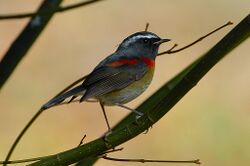Biology:Tarsiger
| Tarsiger | |
|---|---|

| |
| Collared bush robin (Tarsiger johnstoniae) | |
| Scientific classification Error creating thumbnail: Unable to save thumbnail to destination
| |
| Domain: | Eukaryota |
| Kingdom: | Animalia |
| Phylum: | Chordata |
| Class: | Aves |
| Order: | Passeriformes |
| Family: | Muscicapidae |
| Subfamily: | Saxicolinae |
| Genus: | Tarsiger Hodgson, 1845 |
| Type species | |
| Tarsiger chrysaeus (golden bush robin) Hodgson, 1845
| |
Tarsiger is a genus of six species of birds in the family Muscicapidae. They are small, mostly brightly coloured insectivorous birds native to Asia and (one species) northeastern Europe; four of the six species are confined to the Sino-Himalayan mountain system.[1] The genus has sometimes been included within the related genus Luscinia, but the species have been found to form a distinct monophyletic group.[2]
Taxonomy
The genus Tarsiger was introduced in 1845 by the English naturalist Brian Houghton Hodgson with the golden bush robin as the type species.[3][4] The genus name is from Ancient Greek tarsos, "flat of the foot" and Latin gerere, "to carry".[5]
The genus contains the following species:[6]
- White-browed bush robin (Tarsiger indicus)
- Rufous-breasted bush robin (Tarsiger hyperythrus)
- Collared bush robin (Tarsiger johnstoniae)
- Red-flanked bluetail (Tarsiger cyanurus)
- Himalayan bluetail (Tarsiger rufilatus)
- Golden bush robin (Tarsiger chrysaeus)
The Himalayan bluetail was formerly treated as a subspecies of the red-flanked bluetail.[1] It was split on the basis of its more intense plumage colours, and its ecology and behaviour, being a short-distance altitudinal migrant not a long-distance migrant.[7]
The phylogenetic relationships between the species were determined in a molecular phylogenetic study published in 2022:[8]
| Tarsiger |
| ||||||||||||||||||||||||||||||
References
- ↑ 1.0 1.1 Collar, N.J. (2005). "Genus Tarsiger". in del Hoyo, J.; Elliott, A.; Christie, D.A.. Handbook of the Birds of the World. 10: Cuckoo-shrikes to Thrushes. Barcelona, Spain: Lynx Edicions. pp. 754–756. ISBN 978-84-87334-72-6. https://archive.org/details/handbookofbirdso0010unse/page/754/mode/1up.
- ↑ Sangster, G.; Alström, P.; Forsmark, E.; Olsson, U. (2010). "Multi-locus phylogenetic analysis of Old World chats and flycatchers reveals extensive paraphyly at family, subfamily and genus level (Aves: Muscicapidae)". Molecular Phylogenetics and Evolution 57 (1): 380–392. doi:10.1016/j.ympev.2010.07.008. PMID 20656044.
- ↑ Hodgson, Brian Houghton (1845). "Abstract of a paper on Nepalese birds". Proceedings of the Zoological Society of London 13: 22–37 [28]. https://www.biodiversitylibrary.org/page/12862524.
- ↑ Mayr, Ernst; Paynter, Raymond A. Jr, eds (1964). Check-List of Birds of the World. 10. Cambridge, Massachusetts: Museum of Comparative Zoology. p. 33. https://www.biodiversitylibrary.org/page/14486222.
- ↑ Jobling, James A. (2010). The Helm Dictionary of Scientific Bird Names. London, United Kingdom: Christopher Helm. p. 379. ISBN 978-1-4081-2501-4. https://archive.org/details/Helm_Dictionary_of_Scientific_Bird_Names_by_James_A._Jobling.
- ↑ Gill, Frank; Donsker, David; Rasmussen, Pamela, eds (January 2022). "Chats, Old World flycatchers". IOC World Bird List Version 12.1. International Ornithologists' Union. https://www.worldbirdnames.org/bow/chats/. Retrieved 4 August 2022.
- ↑ Rasmussen, Pamela C.; Anderton, John C. (2012). Birds of South Asia. The Ripley Guide. 2: Attributes and Status (2nd ed.). Washington D.C. and Barcelona: Smithsonian National Museum of Natural History and Lynx Edicions. pp. 393–394. ISBN 978-84-96553-87-3.
- ↑ Wei, C.; Sangster, G.; Olsson, U.; Rasmussen, P.C.; Svensson, L.; Yao, C.-T.; Carey, G.J.; Leader, P.J. et al. (2022). "Cryptic species in a colorful genus: Integrative taxonomy of the bush robins (Aves, Muscicapidae, Tarsiger) suggests two overlooked species". Molecular Phylogenetics and Evolution 175: 107580. doi:10.1016/j.ympev.2022.107580. PMID 35810968.
Wikidata ☰ Q968266 entry
 |

